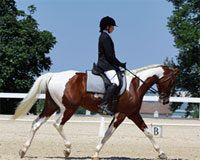A half-halt isn’t: pulling the reins. To start out, riding instructors often teach beginners very simplistic aids to take the place of certain skills until the rider’s balance and body control improves. This is particularly true of the half-halt. Since one of the requirements of the half-halt is having the ability to “ride along” or move your body along with the horse’s motion, you can understand how making a proper half-halt is nearly impossible to the rank beginner who is concentrating on so many things—holding the reins, sitting up, learning the rhythm of the rising trot, turning. Therefore, for a little while, the beginning rider may have to rely on pulling the reins to slow down or stop. Unfortunately, this aid often continues to become the rider’s way of half-halting forever. This way of braking eventually creates problems. Constantly having the bit pulled in his mouth is an unpleasant experience for the horse, which often leads to his resistance. If a rider’s answer to the problem is changing to a stronger bit or using training aids such as draw reins, it becomes a vicious cycle. Instead, master the subtle skill of the half-halt.
Further Reading
Two Half-Halt Exercises
Half-Halt How-to
American author Sharon Biggs is a freelance writer currently based in England.







I think the article is good. I use the half-halt when I do the legyield and the turn on the four hand. It tells the horse that he has to do something, and he does it.It is a very good aid.And it is something that a horse knows that signal.I have been learning it for a long time.
this helped me understand half halt much better.
This article is a great start to learning what is and isn’t a half halt. I’m in the very beginning stages of learning dressage and/or hunt. I liked the article and want to know more about it. Having the theories behind the half halt helped me understand the meaning behind why it’s done.
This a great aticle!It is very true.I can watch my best friend(a complete beginner) ride and wonder why her trainer is not screaming at her for yanking on her horses head,and then watch when some of my more avanced friends and see how efficently they ride.There is very little pulling.
This was a very helpful article. I used to pull on the reins alot. This is a really good and clear explination.
I DIDN’T KNOW THAT THANKS!!! 🙂
A very basic but clear article on the beginnings of teaching the half-halt. I am a riding instructor for many beginners, girls all the way down to 5 years old and I have to agree totally that even starting to use this technique can only be done after a lot of basic training progress has been made. I try to teach my kids to use leg and seat body language to slow their horses, reins very slightly if possible.
The way I teach the half halt to the young ones: “start to ask for a whoa (with body language) and then stop asking the second you feel a slow down”
Perfect! Finally an explanation of an advanced concept in a way that just anybout any level of rider can understand. Well done! : )
Thank you for this really great insight on the half-halt! It’s going to really help!
i know im the best rider ever!!!!!!!!!!!!!!! Im right!!!!!!!!!!!!!!!!!!!!!!!!!!!!!!!!!!!!!!!!!!your wrong!!!!!!!!!!!!!!!!!
Makes so much more sense!
In so many different recources I’ve heard so many different things about perfecting of performing half halts. Some sources claim that half halts are for making a horse round and on the bit, others say that they should create more impulsion, and others say that they should slow a horse down. I do not get it.
Thanks for the article i was wondering how to do a half-halt correctley
good article
good article
A half-halt is a communication tool — a brief squeeze-and-release of the inside rein that is used to re-balance/re-collect the horse (usually) prior to a change of gait.
Currently, I do little twitches of the reins to half-halt in order to keep the sitting trot. My goal is to move to what the article says and use my body as a communicator more than my hands. I started with the legs and am moving up.
I think I need to practice, practice, and then more practice. I have a young filly so it is hard to try to teach everything at once,
We take a breath and slowly exhale as a cue to asking our horses to slow and halt. At the same time we do a small pelvic tilt. Our beginners can learn this easily and this also gets them to sit more firmly in the saddle which gives the horse a good cue.
A half-halt is particularly good on the trail when your horse won’t keep his NOSE off the horse’s BUTT in front of him! I use the voice cue “OFF” when he (and I) aren’t paying attention — a great way to get cracked. Half-halts aren’t just English…
Great article, very informative and helpful.
Thank you for this very helpful gesture!!! I tried this on my horses and It worked. I have a stubborn horse and he does not want to stop when you want him to. But now, when u tried this, he works on command.
Thanx!